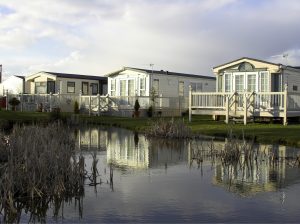Today’s manufactured housing communities aren’t what you think
Posted on July 1, 2022
When you hear about manufactured housing communities, you probably picture a trailer park alongside the highway. Despite what you might think, manufactured homes aren’t mobile, and they look nothing like what you might imagine.
The term “manufactured home” describes houses built entirely in factories after 1976, when HUD established the Manufactured Home Construction and Safety Standards. Unlike mobile homes built decades ago, manufactured homes span all demographics and provide a high-quality yet affordable alternative to site-built homes.
According to the Manufactured Housing Institute, more than 22 million people in the United States live in manufactured homes. There are approximately 8.5 million manufactured homes in about 40,000 manufactured housing communities throughout the country. Over the past five years, the manufactured home share of single-family homes has increased compared to site-built homes across the country, comprising just under 10% of the housing stock in America.
Recently, states like Florida, South Carolina, North Carolina, and Georgia have seen sizeable increases in the number of manufactured houses built and sold. In fact, it’s estimated that one in every five homes sold in Florida is factory-built.
Why are manufactured houses growing in popularity? For many homebuyers, a manufactured home provides an opportunity to live in a high-end community without sacrificing suburban amenities, like backyards, swimming pools, tennis courts, golf courses, and even boat ramps. They offer a number of advantages, including not only affordability, but also low maintenance, superior quality control, and increased safety.

Affordability
Because manufactured homes are built in a controlled, streamlined factory environment, material costs are lower overall. Builders don’t have to worry about weather-related damage and can often buy materials in bulk. As a result, manufactured homes can cost up to 50% less to build. While a site-built home costs an average of $114 per square foot, a manufactured home costs an average of $55 per square foot.
In December of 2021, the average price of a manufactured house was $123,200, while a site-built home at the same time cost $320,662 on average. There can be additional costs of owning a manufactured home, including the cost of the land and customizations, but that price difference is still significant.
While manufactured housing is seen as a possible solution to the country’s affordable housing crisis, not all manufactured homes are cheap. Across the country, particularly in coastal towns, there are luxury manufactured communities where factory-built homes may cost more than the national average family dwelling. While costs range depending on location, manufactured homes provide an affordable way for people to purchase a single-family dwelling in a desirable area.
That makes them ideal for millennials and Gen Z homebuyers, who have less buying power than their parents did at their stage of life. They also provide an excellent option for seniors looking to downsize while maintaining the features they love about their detached homes.
Excellent quality control
Manufactured homes undergo frequent rigorous inspections and are subject to standards put in place by the U.S. Department of Housing and Urban Development. HUD created the Office of Manufactured Housing Programs for the sole purpose of overseeing construction standards and providing consumers with resources for preserving their homes.
Since those standards have been put in place, the quality of factory-built homes has improved tremendously. There are compliance standards for structural integrity as well as energy efficiency, fire and wind resistance, ventilation, plumbing, and heating and air.
Safer in hurricanes
Thanks to HUD standards, the safety of manufactured homes has come a long way. Manufactured homes are now built for specific wind zones with the capability of withstanding hurricane-force winds. A 2014 IBHS test found that manufactured homes actually perform better in high winds than site-built houses when attached structures are properly installed.
Fire resistance
While mobile homes are notorious for burning quickly when a housefire occurs, manufactured homes are much safer. From 2007 to 2011, the death rate as a result of fire for manufactured homes was 57% lower than in pre-1976 factory-built homes. The HUD codes introduced in 1976 include a number of fire-resistant features, including strict standards for flame spread and smoke generation. As a result, manufactured homes have 38-44% fewer fires than site-built homes, and the flame damage from fires in manufactured homes is more likely to be contained within the room of origin than in site-built homes.
Manufactured housing communities have come a long way over the past several decades and will likely continue to grow in popularity. As the affordable housing crisis intensifies, manufactured homes can help fill in the gaps by combining the best of suburban features, like privacy and desirable amenities, with the low maintenance and affordability of apartment living.
